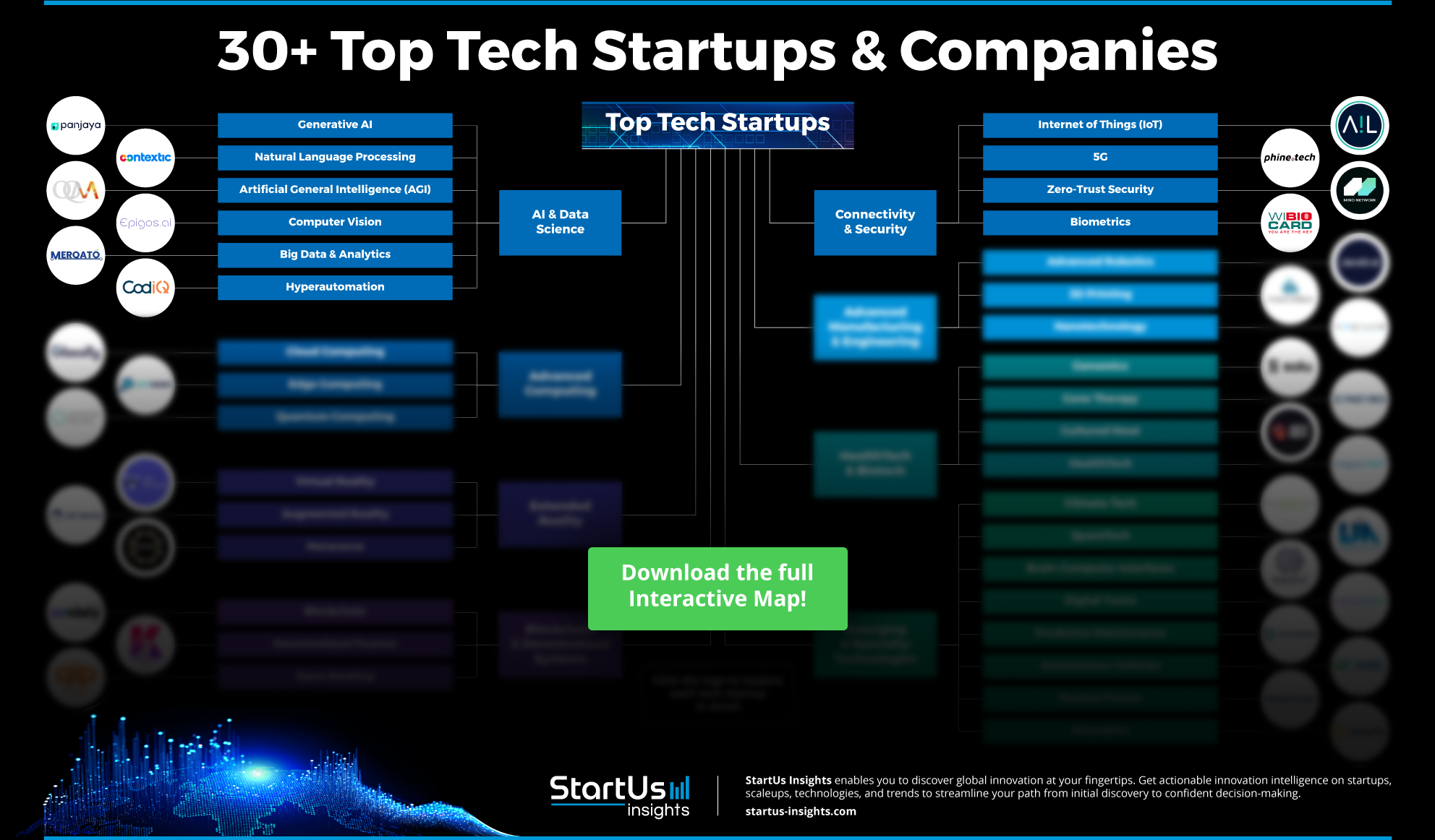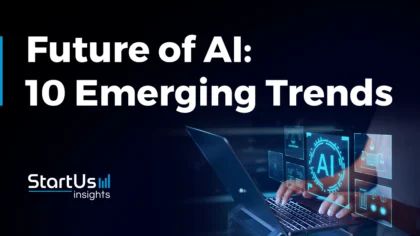Artificial intelligence (AI) enables real-time data analysis, automates complex workflows, and enhances predictive capabilities for more precise decision-making. For instance, advancements in natural language processing (NLP) analyze and interpret large volumes of unstructured data rapidly. It provides better customer insights and improved service delivery. Additionally, machine learning algorithms optimize supply chain management by predicting demand fluctuations and reducing operational costs.
As the pace of technological change accelerates, stakeholders must adapt to these innovations to maintain competitiveness and align with rapid advancements as well as shifting consumer expectations.
Why should you read this report?
- Gain insights into the top 10 enabling technologies impacting AI.
- Learn about three practical use cases for each technology.
- Meet 10 innovative startups advancing these technologies.

Key Takeaways
- Natural Language Processing
- Use Cases:
- AI Assistants
- Machine Translation
- Speech-Text Transcription
- Startup to Watch: Divinia
- Use Cases:
- Machine Learning
- Use Cases:
- Recommendation Systems
- Threat Detection
- Predictive Analytics
- Startup to Watch: Safebooks
- Use Cases:
- Robotic Process Automation
- Use Cases:
- Procurement Automation
- Payment Processing
- Records & Data Management
- Startup to Watch: Atomatik
- Use Cases:
- Digital Twins
- Use Cases:
- Smart Grid Management
- Manufacturing Simulations
- Smart City Infrastructure
- Startup to Watch: Revalgo
- Use Cases:
- AIoT
- Use Cases:
- Smart Agriculture Monitoring
- Smart City Autonomous Vehicles
- Smart Homes
- Startup to Watch: AIMLWare
- Use Cases:
- Generative AI
- Use Cases:
- Synthetic Data Generation
- Virtual Avatars and Digital Humans
- Model Content Creation
- Startup to Watch: Mistral AI
- Use Cases:
- Deep Learning
- Use Cases:
- Natural Language Understanding (NLU)
- Cybersecurity Solutions
- Generative Adversarial Networks (GANs)
- Startup to Watch: Small Pixels
- Use Cases:
- Computer Vision
- Use Cases:
- Facial Recognition
- Automated Quality Inspection
- Visual Data Processing
- Startup to Watch: VitVio
- Use Cases:
- Explainable AI (XAI)
- Use Cases:
- Healthcare Treatment Recommendations
- Financial Loan Approval Transparency
- Hiring Algorithms
- Startup to Watch: Intellico
- Use Cases:
- Quantum AI
- Use Cases:
- Material Science
- Cryptography and Cybersecurity
- Drug Discovery & Molecular Simulation
- Startup to Watch: Xatoms
- Use Cases:
What You Need to Know About Artificial Intelligence
What is the future of artificial intelligence?
- Edge AI and On-Device Processing: AI models shift from centralized cloud-based processing to edge devices for faster real-time analytics. This decentralization reduces latency and improves privacy, particularly for industries like healthcare and autonomous vehicles.
- Explainable AI (XAI): XAI grows to make machine learning models transparent while enabling businesses to trust and validate AI systems’ decisions, especially in sensitive fields like finance and legal services.
- Generative AI and Natural Language Processing (NLP): Such advances allow AI to create human-like text, art, and even code. These technologies automate content creation, design, and customer support to enhance personalization and operational efficiency.
- AI-Integrated IoT Systems: AI-enhanced Internet of Things applications include smart sensors and AI algorithms to provide predictive maintenance in manufacturing, optimize energy consumption in smart grids, and improve supply chain efficiency.
- Human-Centric AI: Future AI systems will collaborate between humans and machines. The emphasis will be on augmenting human decision-making with AI insights, especially in complex scenarios like medical diagnostics, risk analysis, and customer experience management.
How do machine learning & artificial intelligence technologies help businesses?
- Predictive Analytics for Decision-Making: Businesses leverage machine learning models to analyze historical data and forecast trends. For example, retail companies use predictive analytics for demand forecasting, inventory management, and personalized marketing, enabling accurate and timely business decisions.
- Process Automation & Optimization: AI technologies automate repetitive tasks, freeing up human resources for more strategic activities. Robotic Process Automation (RPA), backed by machine learning, streamlines workflows in finance, customer service, and human resources to increase efficiency and reduce error rates.
- Customer Experience Enhancement: AI technologies, including NLP and sentiment analysis, assist businesses in understanding and responding to customer needs. Virtual agents, chatbots, and AI-driven recommendation engines provide personalized user experiences for higher customer satisfaction and loyalty.
- Enhanced Cybersecurity: Businesses utilize AI for proactive cybersecurity measures. Machine learning algorithms detect anomalies in network behavior, identify potential threats in real-time, and automate incident responses to provide a layer of protection against cyberattacks.
- Supply Chain Optimization: AI and machine learning analyze data from various sources to improve demand forecasting, reduce logistics costs, and mitigate risks associated with disruptions or delays.
- Personalization and Marketing Automation: AI algorithms analyze customer data, such as purchase behavior and preferences, to provide personalized content and offers. This targeted marketing increases conversion rates and revenue growth by ensuring that businesses interact with customers in a more meaningful and relevant way.
Where We Get Our Data From
StartUs Insights gathers data through its exhaustive Discovery Platform, covering information on 4.7+ million startups, scaleups, and tech companies globally, alongside 20K+ emerging technologies and trends. The Discovery Platform accelerates startup and technology scouting, trend intelligence, and patent searches, offering thorough insights into technological advancements. By leveraging the trend intelligence feature for this report, we identified emerging technologies within specific industries. This process allows us to uncover patterns and trends, and pinpoint relevant use cases and the startups creating solutions for each scenario. Additional capabilities and information can be found at StartUs Insights Discovery Platform.
10 Emerging Technologies Impacting the Future of AI [2025 & Beyond]
1. Natural Language Processing (NLP)
NLP utilizes large language models (LLMs) to change the way machines understand and generate text for processing complex linguistic tasks with accuracy. Techniques such as named entity recognition (NER), sentiment analysis, and natural language generation (NLG) extract insights from unstructured data to interpret human language and respond intelligently. Additionally, innovations in NLP, including transformers and generative models, enhance capabilities in tasks like machine translation and automated content generation.
3 Practical Use Cases of NLP:
- AI Assistants: NLP processes natural human language to perform tasks like answering questions, scheduling appointments, and controlling smart devices. It enables these assistants to understand complex user inputs, capture context, and respond conversationally for a more human-like interaction. This improves user engagement and streamlines business processes by providing personalized support and automating routine inquiries to increase efficiency and customer satisfaction.
- Machine Translation: It improves translation accuracy by understanding context, sentence structure, and cultural nuances beyond mere word-for-word conversion. Adaptive machine translation grows with usage and feedback to provide refined translations that meet the specific requirements of various languages and industries. This application reduces language barriers, enhances multilingual communication, and interacts cross-border for content localization and customer support.
- Speech-Text Transcription: The technology converts spoken language into written form. It breaks down speech into analyzable tokens and converts them to text accurately. Also, it offers applications like voice search, automated meeting notes, and real-time transcriptions to enhance accessibility, data management, and operational efficiency.
Startup to Watch: Divinia
US-based startup Divinia leverages proprietary AI technologies to develop products that enhance content creation and information retrieval. The company’s technology stack includes Divinia NLP which features unsupervised models for concept and sentiment analysis, language generation, and image-text matching. These technologies provide applications like review analysis, summarization, product selling point extraction, video script generation, and semantic alignment between images and text.
The company’s tool, Divideo, uses its media library to create professional marketing videos by converting customer reviews into content. Additionally, Divinia’s AI-driven search solutions provide personalized insights from customer reviews to assist consumers in finding hotels, cars, or shoes. This approach enhances decision-making by combining AI’s efficiency with real user experiences to improve the impact of content and search outcomes.
2. Machine Learning
Machine learning utilizes algorithms that enable computers to learn from and make predictions based on data. It employs techniques such as supervised learning, unsupervised learning, and reinforcement learning to analyze vast datasets and identify patterns while extracting insights without explicit programming.
Recent innovations in machine learning include the integration of neural networks and deep learning frameworks, which enhance the models to process complex inputs, such as images and text. Technologies like AutoML streamline the model-building process to create effective machine learning solutions with minimal coding. Further, the rise of multimodal machine learning enables systems to integrate and analyze data from various sources for enhancing overall model performance.
3 Practical Use Cases of Machine Learning:
- Recommendation Systems: Machine learning analyzes user behavior, preferences, and past interactions to generate personalized suggestions across various platforms. Among others, it optimizes user experiences in e-commerce, streaming services, and social media by tailoring product, content, or connection recommendations. Thus, it enhances customer satisfaction, increases engagement, and improves conversion rates by enabling more targeted marketing and recommendations.
- Threat Detection: Machine learning continuously monitors user and system behaviors to identify anomalies that indicate cyber threats or insider attacks. It uses dynamic learning models that adapt to evolving cyberattack techniques while enabling proactive defense against complex threats. In industries dealing with sensitive data, such as finance and healthcare, this application reduces false positives, enhances security response times, and mitigates risks by highlighting hidden threats before they escalate.
- Predictive Analytics: Analysis of historical data and patterns allows forecasting future outcomes in real-time, and supports decision-making across industries like finance, supply chain, and healthcare. Businesses leverage these insights for demand forecasting, risk management, and proactive maintenance, which improves operational efficiency and resource allocation. This minimizes losses and optimizes processes.
Startup to Watch: Safebooks
Israeli startup Safebooks offers a financial data governance platform to automate financial controls for ensuring real-time data completeness, accuracy, and integrity. The platform consolidates financial data into a unified warehouse and uses AI and ML to detect anomalies, fraud, and discrepancies. It automates reconciliations and provides real-time insights to ensure flawless audit trails and a single source of truth for financial data.
The platform offers benefits, such as automated AI-powered controls for consistent data monitoring, work-paper automation for error detection, and real-time transaction reviews to identify and address issues promptly. Safebooks’ solutions allow for a quick and simple setup to manage internal controls and audit preparations effectively.
3. Robotic Process Automation (RPA)
RPA streamlines repetitive tasks to enhance operational efficiency. The technology integrates with AI, particularly through the use of machine learning and cognitive intelligence to allow RPA systems to adapt to environments and manage unstructured data effectively. Innovations in RPA include hyperautomation, which combines RPA with intelligent automation. Moreover, low-code platforms develop automation workflows while democratizing access to RPA technologies across various departments.
3 Practical Use Cases of Robotic Process Automation:
- Procurement Automation: RPA streamlines procurement by automatically managing tasks like purchase requests, order creation, and inventory tracking to reduce errors and ensure efficient workflows. This technology improves efficiency by speeding up procurement cycles, enhancing supplier communication, and maintaining accurate inventory levels. Consequently, RPA in procurement increases overall process efficiency, reduces manual effort, and allows the procurement team to focus on strategic activities such as negotiating better contract terms and optimizing supplier performance.
- Payment Processing: It generates invoices, tracks payment statuses, and reconciles accounts to manage payment cycles. RPA reduces manual intervention to improve cash flow management and payment processing times. This enhances financial accuracy and better compliance with payment terms for improved overall financial health.
- Records & Data Management: The technology ensures real-time data updates, accurate data entry, and compliance with regulatory requirements. By extracting, validating, and updating customer and operational data across various systems, it maintains accurate records while reducing manual errors. This leads to better decision-making, improved compliance, and efficient handling of large volumes of data for enhancing the quality and speed of data-driven processes across industries such as healthcare, finance, and supply chain management.
Startup to Watch: Atomatik
US-based Atomatik improves digital transformation through its automation platform to offer intelligent document processing, user interface (UI) automation, no-code development, and process orchestration to streamline business workflows. It combines AI/ML technologies with semantic understanding to extract data from different documents and automates tasks across multiple systems using drag-and-drop tools without requiring coding expertise.
Its integrated layers provide a single source of truth for data to ensure security through on-premises or cloud-based encryption and role-based access while providing real-time insights and collaboration between human and digital workers. Its features include a design studio for workflow creation, digital workers trained for data extraction and validation, and a control room for scheduling and performance management.
4. Digital Twins
Digital twins create virtual replicas of physical objects, systems, or processes. It integrates real-time data from various sensors and devices to simulate and analyze the behavior of their physical counterparts. Thus, it enables organizations to optimize performance and predict outcomes. Its integration with AI allows for advanced predictive analytics and scenario modeling to acclerate decision-making across diverse sectors such as manufacturing, healthcare, and urban planning. Technologies like machine learning and IoT sensors gather and process data, while generative AI further refines these models to offer deeper insights and proactive management strategies.
3 Practical Use Cases of Digital Twins:
- Smart Grid Management: Digital twins enable smart grid management by creating a virtual representation of the physical grid system by integrating real-time data from IoT devices, sensors, and other operational systems. This allows for accurate load forecasting, detailed grid visualizations, and early detection of potential issues like bottlenecks or voltage deviations. Its benefits include increased energy efficiency, reduced operational risks, and better utilization of existing grid infrastructure. Thus, it enables grid operators to respond swiftly to fluctuating demand and optimize capacity while enhancing grid reliability.
- Manufacturing Simulations: It simulates production processes, from machine operations to supply chain flows, by mirroring real-world assets and their behaviors in a virtual environment. This application analyzes equipment performance, optimizes production schedules, and predicts potential failures before they occur. Thereby, it improves operational efficiency, reduces downtime, and enhances flexibility in manufacturing processes.
- Smart City Infrastructure: The technology serves as a virtual model of urban environments while integrating spatial data, IoT sensor feeds, and public/private datasets. It assists city planners in visualizing energy grids, transportation systems, emergency response scenarios, and environmental factors for developing and testing urban strategies effectively. The advantages include better decision-making in urban planning, enhanced public safety and health management, and support for sustainable development and infrastructure.
Startup to Watch: Revalgo
US-based startup Revalgo offers a Conversational Commerce platform to automate and enhance sales and supply chain processes by creating a digital twin of a company’s physical operations. It leverages AI to automate customer conversations and converts traditional workflows into digital systems that respond to customer demands across multiple channels, including emails, texts, messaging apps, chatbots, and voice calls.
The platform’s Sales Automation builds a digital replica of the sales force and converts complex sales tasks into revenue opportunities. In supply chain automation, Revalgo’s Sourcing Automation centralizes stock and non-stock product information, to enable decisions based on real-time price, availability, and promotions without manually contacting suppliers. The platform integrates with enterprise resource planning (ERP) systems to automatically convert customer requests into sales orders or quotes, with real-time visibility into the raw input and AI-based conversions.
5. AIoT
The integration of AI and IoT known as AIoT enhances data processing and connectivity. It utilizes AI algorithms to enable intelligent analysis and decision-making capabilities within interconnected devices. This technology combines advanced analytics, machine learning, and edge computing, which reduces latency by processing data closer to the source for enhanced response times and operational efficiency. Additionally, AIoT systems leverage distributed intelligence that allows devices to learn and adapt autonomously for improved resource management and predictive maintenance capabilities.
3 Practical Use Cases of AIoT:
- Smart Agriculture Monitoring: AIoT combines IoT-based data collection with AI-driven insights for real-time monitoring and management of crops, pest control, soil health, and weather conditions. This integration provides farmers with timely and accurate predictions, better crop management, and efficient resource utilization to increase productivity, reduce costs, and improve sustainable farming practices.
- Smart City Autonomous Vehicles: In smart city environments, AIoT connects autonomous vehicles to 5G networks and city infrastructure for real-time decision-making and navigation. The technology improves safety by enabling vehicles to respond to dynamic urban conditions, such as traffic changes and pedestrian movements, while offering seamless connectivity for vehicle-to-everything (V2X) communications. This leads to safer, more efficient transportation systems, reduced congestion, and better urban mobility solutions.
- Smart Homes: The technology integrates IoT devices with AI to automate home systems, including lighting, security, climate control, and appliances, all managed through a centralized platform. These interconnected systems learn user behaviors, optimize energy consumption, and enhance comfort and safety.
Startup to Watch: AIMLWare
Indian startup AIMLWare provides AI-enabled next-generation IoT hardware products for facility and health management. The company’s technology integrates wireless sensors, such as temperature, humidity, air quality, and motion detectors, into compact hardware for monitoring through a mobile application or centralized master console. Its features include an all-in-one IoT gateway with extensive sensor integrations, advanced workflow, and rule engines, and contactless facility management tools for access control and health surveillance.
AIMLWare’s products include the V-Sense AMW2000 and AMW3000 series for contactless temperature measurement and thermal imaging, the AMW7500 IoT gateway for sensor interfacing, and the AMW7600 all-in-one sensor system. Additionally, the AMW7700 smart switch enables intelligent power monitoring and control of electrical appliances to increase efficiency and lower energy consumption.

6. Generative AI (GenAI)
Generative AI leverages deep learning techniques, particularly neural networks like transformers and generative adversarial networks (GANs), to create complex media outputs such as text, images, and audio that closely mimic humans. Transformers, like those used in large language models, excel at natural language generation and understanding, while GANs enable the creation of highly realistic images and video content.
Techniques such as variational autoencoders (VAEs) facilitate data compression and reconstruction for efficient media generation. Reinforcement learning improves model performance by fine-tuning outputs based on iterative feedback. Moreover, innovations in architectures like diffusion models and advancements in transfer learning improve applications in content creation, human-computer interaction, and real-time personalization.
3 Practical Use Cases of Generative AI:
- Synthetic Data Generation: Generative AI generates synthetic data by creating realistic datasets that mimic real-world data for training machine learning models in challenging scenarios. This assists industries by improving model development, enhancing data privacy through anonymization, and enabling the testing of AI algorithms without expensive or sensitive real-world data collection.
- Virtual Avatars & Digital Humans: It uses generative models to create lifelike avatars to interact in virtual environments and offer applications in gaming, customer service, and virtual reality experiences. This enhances user engagement through realistic simulations and personalized experiences, supports branding and marketing through interactive digital characters, and assists businesses develop immersive customer support and entertainment solutions.
- Model Content Creation: The technology autonomously generates text, images, audio, and video based on specified inputs for use cases like automated writing, design prototyping, and multimedia production. It offers faster content production cycles, cost savings in creative processes, and customized content on-demand for various platforms and audiences for better audience engagement and streamlined creative workflows.
Startup to Watch: Mistral AI
Mistral AI develops advanced AI models to offer open and optimized tools for building intelligent applications. Its platform includes general-purpose models like Mistral Large 2 for complex tasks with extensive multilingual capabilities, and Mistral Small 24.09, a cost-effective model ideal for tasks such as translation and summarization.
Specialized models like Codestral assist with code tasks while Mistral Embed provides high-performance semantic extraction for text, and Pixtral 12B enables image analysis without third-party file uploads. Moreover, the company’s platform serves as a developer hub, hosted on Mistral’s EU-based infrastructure, to offer easy access, secured data handling, and community support. With these, it allows for fine-tuning models to suit specific use cases through Mistral’s proprietary fine-tuning code or via an API.
7. Deep Learning
Deep learning leverages algorithms to analyze and interpret complex data structures. This technology relies on neural networks, particularly deep neural networks (DNNs), which consist of multiple layers that process information hierarchically. Additionally, it uses convolutional neural networks (CNNs) for image analysis and recurrent neural networks (RNNs) for sequential data processing. Moreover, it includes innovations like transfer learning that enable models to leverage knowledge gained from one task and apply it to another to reduce training time. Further, the integration of federated learning allows the training of models across decentralized devices while preserving data privacy.
3 Practical Use Cases of Deep Learning:
- Natural Language Understanding (NLU): The technology analyzes text to understand context, semantics, and linguistic nuances for applications like chatbots, voice assistants, and language translation tools. This assists industries such as customer service, e-commerce, and content creation by enhancing automation, providing personalized interactions, and allowing for accurate language-based data processing in multiple languages and contexts.
- Cybersecurity: In cybersecurity, deep learning strengthens threat detection by analyzing network traffic, user behavior, and system logs to identify anomalies and detect potential threats such as malware, phishing, and intrusions. It allows security systems to respond quickly to emerging cyber risks, reduces false positives, and enhances the overall security posture of organizations for ensuring data integrity and protecting critical infrastructure for sectors like finance, healthcare, and government.
- Generative Adversarial Networks (GANs): GANs leverage deep learning to generate high-quality synthetic data, images, videos, and other forms of content by pitting two neural networks against each other: a generator and a discriminator. This technology benefits industries involved in creative design, entertainment, and data augmentation. Also, it produces lifelike visuals, simulates scenarios for training AI models, and creates new media content and virtual environments with high fidelity and realism.
Startup to Watch: Small Pixels
Italian startup Small Pixels builds SPAIQ, a suite of AI-powered video enhancement technologies that improve video quality in real-time while reducing bandwidth consumption. SPAIQ Stream leverages AI and deep learning to upscale and restore videos while enabling up to 4K resolution and saving bandwidth through compression-resistant algorithms. SPAIQ Client enhances end-user experience across devices like mobiles, PCs, and smart TVs by integrating AI upscaling directly into the video player to provide top-quality playback with minimal computational power and sustainability benefits.
Further, SPAIQ ScaleUp offers AI resolution upscaling from 360p to 4K, both server-side and client-side, for web, mobile, and broadcast content through cloud or on-premises deployment. SPAIQ Archive, a server-side video restoration solution, addresses video degradation from issues like compression and analog artifacts and offers one-shot or batch restoration. Thus, these solutions ensure improved user experiences and enable broadcasters to maximize savings by providing quality content over low-bandwidth networks.
8. Computer Vision
Computer vision enables machines to interpret and understand visual data. This technology employs advanced algorithms, particularly convolutional neural networks (CNNs) and deep learning techniques, to analyze and process images and video in real-time. Innovations in 3D computer vision further enhance these capabilities by allowing systems to capture depth information and create detailed spatial representations. Moreover, the integration of edge computing provides on-device processing while enabling real-time analytics to reduce latency and improve data privacy.
3 Practical Use Cases of Computer Vision:
- Facial Recognition: Computer vision enhances facial recognition by analyzing and identifying human faces from images or video feeds. It utilizes deep learning models to map facial features and compare them against known databases for authentication or surveillance. This enhances security through access control, streamlines customer experiences with personalized services, and supports law enforcement for accurate identification and monitoring in real-time environments.
- Automated Quality Inspection: Manufacturing processes achieve real-time defect detection and quality assurance by analyzing visual data from production lines to identify irregularities, such as surface defects or incorrect assemblies. Further, it reduces manual inspection time, improves product quality, minimizes wastage, and ensures consistent standards to increase operational efficiency and reduce costs.
- Visual Data Processing: The technology interprets and extracts meaningful insights from images and videos for applications like object detection, scene analysis, and content categorization. As a result, it enhances industries like retail through customer behavior analysis, healthcare via medical imaging diagnostics, and logistics with cargo and inventory management to provide faster decision-making, improved accuracy in analysis, and enhanced automation of visual tasks.
Startup to Watch: VitVio
UK-based startup VitVio leverages AI and computer vision to optimize operating room efficiency and minimize administrative burden while enhancing surgical team performance. Its technology tracks surgical tools in real time to reduce equipment waste, provide automated progress monitoring for surgeries, and generate runway estimates to improve scheduling and staff allocation. Additionally, the company supports tailored staff training using actual surgeries from the hospital. Thus, it reduces unplanned overtime, avoids last-minute cancellations, and cuts unnecessary tool usage. Further, it optimizes operating room capacity, improves outcomes, reduces staff burnout, and increases profitability.
9. Explainable AI (XAI)
XAI entails models and algorithms that provide insights into their decision-making processes to understand the outcomes. Techniques such as shapley additive explanations (SHAP) and local interpretable model-agnostic explanations (LIME) enable deeper understanding. They showcase the impact of individual input features on the model’s predictions. Further, advancements in neural network interpretability decode complex AI behaviors to audit and trust these systems. With the integration of ethical frameworks, XAI ensures compliance with regulatory standards. Also, it builds user confidence in AI applications across various sectors, particularly in high-stakes environments like healthcare and finance.
3 Practical Use Cases of XAI:
- Healthcare Treatment Recommendations: XAI enhances healthcare by providing transparency in AI-driven treatment recommendations. It breaks down the analysis of patient data that models carry out and prioritizes treatment options based on specific features, such as medical history, symptoms, and diagnostics. This transparency assists in validating and interpreting recommendations accurately. Also, it ensures regulatory compliance while improving patient outcomes through more informed medical decisions.
- Financial Loan Approval Transparency: XAI allows AI models to explain their decision-making criteria based on factors like credit scores, income, and debt history. Thus, this clarity aids lenders and applicants by promoting fair lending practices and assisting financial institutions to comply with regulations. It improves accountability and reduces biases in credit decision-making.
- Human Resources: The technology provides clear explanations for candidate evaluations and selection criteria. It ensures that AI-driven hiring processes remain fair and aligned with organizational diversity and inclusion goals. As a result, this aids human resource professionals in validating algorithmic recommendations, minimizing biases, and improving transparency in recruitment practices.
Startup to Watch: Intellico
Italian startup Intellico utilizes Grapho, an XAI Engine that enhances decision-making processes through advanced conversation analysis and knowledge graphs. Its features include generative AI capabilities, predictive maintenance for asset management, and environmental, social and governance (ESG) monitoring. These optimize operations across sectors such as smart factories, retail, energy, and smart cities. Further, it provides real-time insights and enables efficient resource management to enhance decision-making clarity and operational effectiveness.
10. Quantum AI
Quantum AI uses the computational ability of quantum mechanics through technologies like quantum algorithms, quantum neural networks, and quantum-enhanced machine learning. It achieves improved data processing speeds and tackles highly complex problems. It leverages quantum circuits, techniques like variational quantum eigensolvers (VQEs), and quantum approximate optimization algorithms (QAOA). With this, it optimizes complex systems, while quantum support vector machines (QSVMs) improve pattern recognition within vast datasets.
Innovations in superconducting qubits, topological qubits, and error correction protocols, such as surface codes and quantum error correction (QEC) techniques, enhance the stability of quantum processors. Moreover, the development of hardware, like trapped ion and photonic quantum computers, combined with AI integration, executes exponentially faster simulations. In addition, it offers cryptographic solutions, and advanced optimization tasks across industries like pharmaceuticals, finance, and materials science.
3 Practical Use Cases of Quantum AI:
- Material Science: Quantum AI leverages quantum computing to simulate and analyze the quantum properties of new materials at a molecular level. Also, it identifies potential structures and behaviors with precision. Further, it develops materials with desirable properties for applications like superconductors, batteries, and sustainable materials and reduces the time and costs of experimentation.
- Cryptography and Cybersecurity: The fusion of quantum AI and cryptography uses quantum algorithms to analyze and break classical encryption schemes. Also, it develops quantum-resistant cryptographic protocols to enhance the security of data transmissions and storage. This impact enables stronger encryption methods to tackle quantum computing threats. It ensures secure communication and data integrity against advanced cyberattacks.
- Drug Discovery & Molecular Simulation: The technology enables rapid molecular simulation and drug-protein interaction predictions. It accurately models complex biological processes and identifies drug candidates. It expedites drug development pipelines, improves the precision of potential drug interactions, and reduces the risks and costs associated with clinical trials.
Startup to Watch: Xatoms
Canadian startup Xatoms leverages AI-assisted quantum chemistry and molecule discovery to identify effective materials for photocatalysts in water treatment solutions. The company utilizes advanced AI algorithms to explore vast chemical spaces to improve the discovery process. Its features include optimization of molecular properties to check the stability of the discovered molecules for deployment in areas with limited access to clean water. Additionally, its AI-powered quantum chemistry calculations simulate and predict the behavior of candidate molecules to reduce experimental costs and time.
Impact of Artificial Intelligence
Patents & Grants & Investment Landscape
Over 95 000 patents filed and more than 25 000 grants awarded indicate a strong emphasis on innovation and R&D in AI. An average investment of USD 286.8T, with 82000+ rounds closed reflects a robust and dynamic investment environment. The top five investors in the startup ecosystem include Y Combinator, Antler, Entrepreneur First, Techstars, and Alumni Ventures.
They provide critical early-stage funding across various industries. Key funding types involve Seed, Early Stage VC/Series A, Pre Seed, Angel, and Venture Round investments. It focuses on sectors such as software development, healthcare, marketing & advertising, financial services, and e-learning.
Global Footprint
Top country hubs are in the USA, India, UK, Germany, and Canada, with major city hubs in London, New York City, San Francisco, Bangalore, and Toronto serving as key innovation nodes.
Act Now to Take Advantage of Top AI Technologies
Take immediate action on the top emerging artificial intelligence technologies to stay ahead in the industry. StartUs Insights empowers you to uncover hidden opportunities among 4.7+ million startups and tech companies, alongside insights into 20K+ technologies and trends. Our AI-powered, real-time database provides unparalleled access to solutions that are not available elsewhere, ensuring you always lead in innovation.
Major companies like Samsung, Nestlé, and Magna rely on our tools to spearhead trends and optimize operations. For instance, here is what Justin Gemeri, the CEO and Co-Founder of ekipa has to say about our platform “Since we regularly collaborate with other startups, StartUs Insights is an elementary tool in our daily business. It saves us an extensive amount of time and resources, which we can distribute to other areas“.
Dive into unmatched data and benefit from a 360-degree industry view for actionable insights. Get in touch with us now to discover how our innovation intelligence can elevate your strategic initiatives.
Discover All AI Innovations & Startups!






